
Last week I talked about the passive aggressive trait of recognizing and dealing with the Zinger. First, in our daily communication and secondly, with how to respond when we are the target. This week we move on to part 2 of the passive aggressive communication series, that I have called the silent punisher.
Have you ever visited with a family member or friend and when you got home your spouse asked how your day was? You simply respond with “I had a great day.” You settle down with your tea and log on to Facebook and the person, with whom you spent the day, has posted a quote or meme that just rubbed you the wrong way? You felt like it was aimed at you but your not sure? On another occasion, after a busy day, you ask your teenager to finish dinner dishes, so you can finally get a few moments to take a bath. He says ok but when you finish your bath, the dishes are haphazardly in the dishwasher, the pans are still in the sink soaking and the counters have not been wiped down? And just yesterday, after your husband had been planning a project for a few weeks, he gets to work on it. A few hours later, you notice he is putting his tools away before he has finished. When you ask him if he going to finish the job, he comments that he will finish it later and he is done for now. Six months later the final touches have not been completed.
You have just been Passively Aggressively played by the Silent Punisher, my friend. In all the above examples, your friend, your son and your husband, each person was feeling resentment, anger, or frustration. Instead of communicating how they felt, they acted out in ways to get you back or show their frustration quietly. All in a different way, these people have acted out instead of speaking up. This is frustrating and it has taken me years to figure out new tools to deal with this.
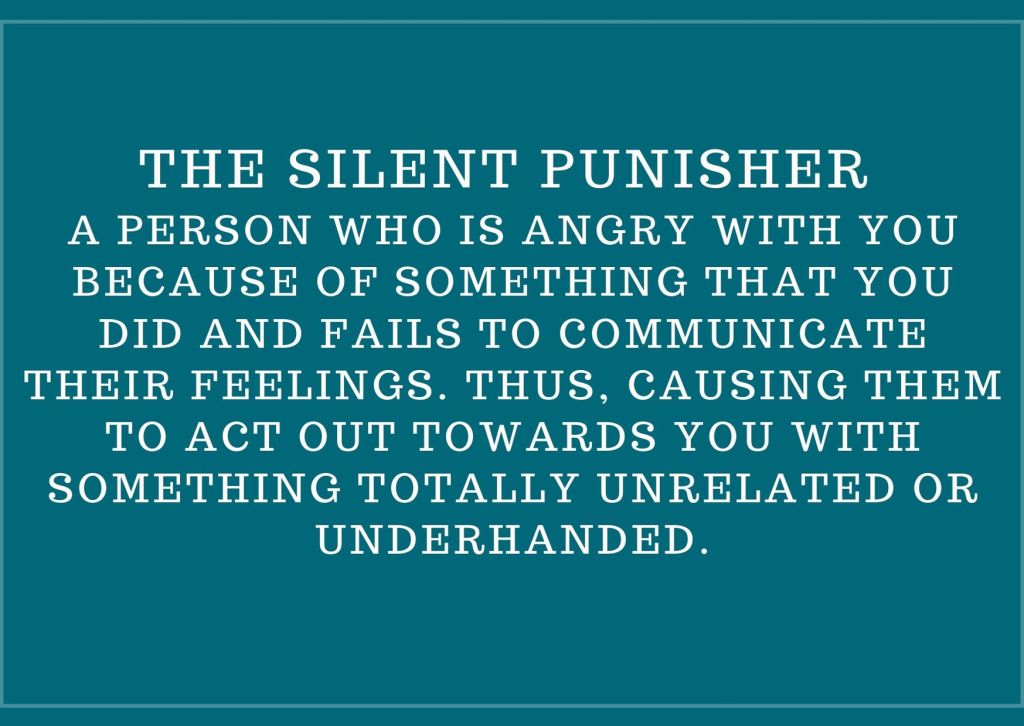
You may be wondering what is the difference between the silent treatment and the silent punisher? (we will discuss the silent treatment in a later part of the series) I will talk through this briefly, to eliminate any confusion. The silent treatment, avoids all conversation and punishes you with complete silence. The silent punisher will still communicate with you, just not about what they are feeling.

Before we can tackle how to handle this form of passive-aggressive behavior we have to be aware of a few things. After studying this behavior, I do not believe that most people that act out passive-aggressively as Silent Punishers are doing this intentionally. Most have seen others model this behavior in childhood or they have no communication tools to help them to communicate clearly when they are angry. They may fear confrontation. They may fear being judged for their feelings. They may have low self-esteem. They may have grown up in a home where emotions were discouraged or invalidated. But It is not your job to figure out why they are doing this unless it is your child and it’s your responsibility to model better behavior or it is YOU displaying this behavior.
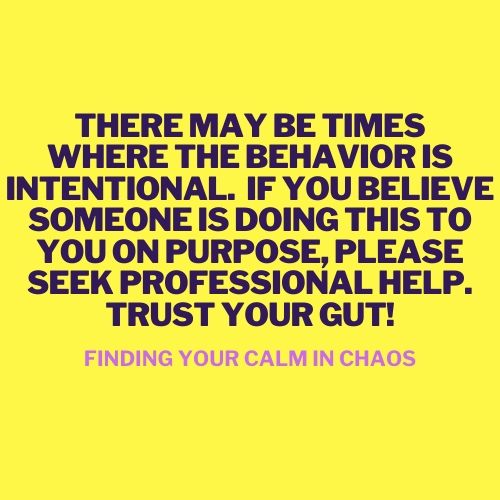
Let’s take a look at the example of the son not doing the dishes correctly. I don’t believe that this teenager is doing this intentionally. In my opinion, he just doesn’t have the communication tools to express himself. Maybe he does not feel you are approachable, that you will validate his feelings or he doesn’t understand the emotions that he is feeling . I think many of these behaviors are taught by our parents and role models to us as children. Of course, most parents did not realize what they were doing nor did they even know this behavior was not effective. We are taught to not show our emotions. We are taught to “let things roll off our backs” to “let things go” to “not be so sensitive” or to “toughen up.” When we say these things to other people what we are essentially saying is not to express themselves or that what they are feeling is not real or important, we are not validating them. When we do not feel validated, we learn not to express ourselves when we are hurt or angry, this builds up resentment. What happens when we are feeling resentful and can not express ourselves? We seek validation anyway we can. We unknowingly plan our silent revenge. We become the silent punisher. Still, following? Let me simplify. To learn more on how we can unknowingly model behavior, check out this video and article on the bobo experiment.
Someone hurts us or angers us. We do not or can not address it. Emotions start to build up. We still won’t talk about it. So we “get the person back” in a manner that is safe for us. We agree to do something when asked but do it wrong or incomplete, we show up late or maybe post something indirectly to feel as if we have approached the situation and somehow we validate our own feelings.
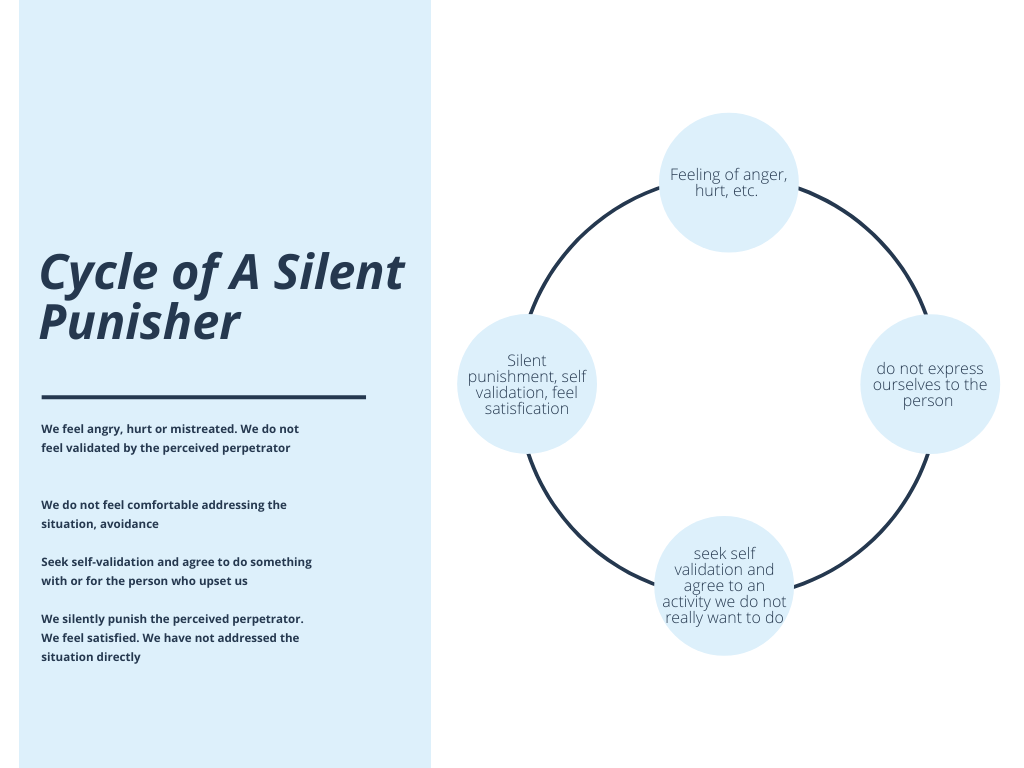
 Take a moment to think about a time when you used the silent punisher with someone instead of effectively communicating your feelings, do you know why you did this?
Take a moment to think about a time when you used the silent punisher with someone instead of effectively communicating your feelings, do you know why you did this?
Let us focus on ourselves. It is always the perfect place to start. We must first recognize that our feelings are valid! We are just as important as the next person. We are human. We get our feelings hurt, and we feel angry. We can learn to change this behavior even if we have been doing it for our entire lives, in fact, we must change this behavior if we are going to find calmness in our lives. Be actively open to understanding your feelings. The chart below explains a helpful tool called a mood check. This is a helpful guide in helping us to determine how we are feeling at any time.
![]()
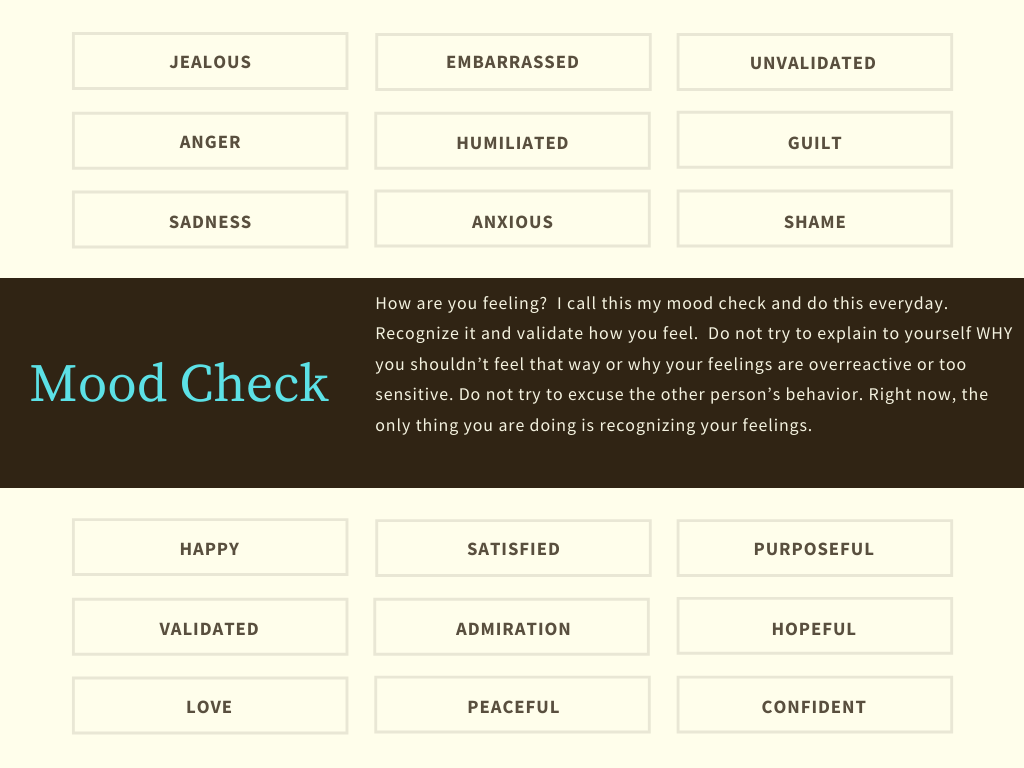
Once we have an understanding of what we are feeling in this situation then we must address it! Oh, the dreaded confrontation is not as bad as you believe it is! This I promise!
Let’s begin with our first example above with our friend and the meme.
Have you ever visited with a family member or friend and when you got home your spouse asked how your day was? You simple respond with “I had a great day.” You settle down with your tea and log on to Facebook and the person, with whom you spent the day, has posted a quote or meme that just rubbed you the wrong way? You felt like it was aimed at you but your not sure?
Let’s reverse the situation. In this example, you are the person posting the meme. You didn’t see that coming, huh? Yes, sometimes we are the silent punisher. You have gone out to dinner with your friend. You were very excited to tell her about your new job. Every time you started to talk to her, she checked her text messages or she would answer her phone. You sat quietly, feeling angry, and ignored. By the time dinner is over, you have yet to tell her about your new job and she is saying her goodbyes and rushing home to her husband and kids. You are left feeling angry, frustrated, ignored, and hurt. After arriving home, the first thing you do is find a meme about how people are so connected to their phones that their personal relationships are suffering and you hit share. She’s also at home reading it and is very confused as to what has just happened.
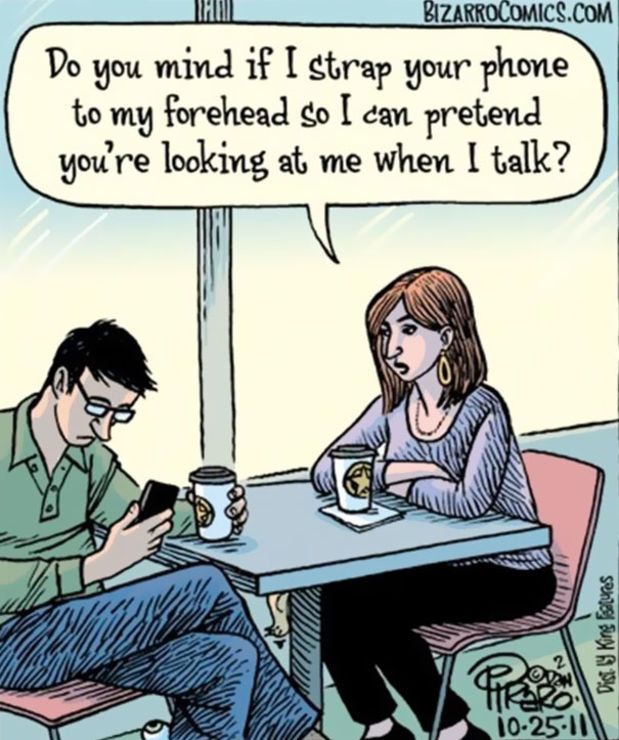
What could you have done here? First, you need to recognize your feelings, MOOD CHECK ![]() . Instead of thinking about her behavior in the car on your way home and becoming angrier. Focus on your feelings and behavior. I feel angry
. Instead of thinking about her behavior in the car on your way home and becoming angrier. Focus on your feelings and behavior. I feel angry ![]() . How can I approach this so it does not happen again? Think about your options because I promise you, there are more ways to handle this than how you have handled this in the past.
. How can I approach this so it does not happen again? Think about your options because I promise you, there are more ways to handle this than how you have handled this in the past.
Instead of a vague meme, let’s approach it directly. Do a mood check ![]() . You decide that the anger has passed and now you are feeling hurt. It’s time to communicate how you feel. This is not as difficult as it sounds and if you fear confrontation you can do this by text. Yes, by text. There is no unwritten rule that states we must handle everything person to person or on the phone. (crazy, huh?)
. You decide that the anger has passed and now you are feeling hurt. It’s time to communicate how you feel. This is not as difficult as it sounds and if you fear confrontation you can do this by text. Yes, by text. There is no unwritten rule that states we must handle everything person to person or on the phone. (crazy, huh?)
First, express your feelings about the situation. Secondly. Briefly explain why you feel that way using an example of the event. Next, Suggest a solution that would work for you and finally validate the other person by letting her know shes is important to you.
 I remember this communication tool by using this nonsense mnemonic. Yes, it is silly but it works.
I remember this communication tool by using this nonsense mnemonic. Yes, it is silly but it works.
Every Week Sunsets Visit
E– Express your feelings W-explain Why S– Solution. V– Validate

I am feeling hurt over something that happened last night. I was excited to tell you about my new job. I did not feel important to you while you were on the phone. We could keep our phones on silent next time we go out or shut them off. I really do enjoy your company.
Let’s break that down. First, express your feelings about the situation ” I am feeling hurt over something that happened last night. I was excited to tell you about my new job.” Next, give an example of what bothered you from the event. “I did not feel important to you while you were on the phone” Suggest a solution “We could keep our phones on silent next time we go out or even shut them off.” You came up with a solution that works for you. “I really do enjoy your company.” you validated her and let her know she was important to you. This is direct and to the point. This is healthy communication.
How she reacts to this situation is completely out of your control. You can only state how you feel and express your needs. I have rarely had this go badly. Most of the time the results are fantastic.
However just in case, if you feel she invalidates your feelings or becomes angry, do not apologize for your feelings or for having upset her! Stay calm and restate what you have said. If she is angry and continues to invalidate your feelings, you simply do not have to go to dinner with her again. There is no need for a lengthy conversation about how you both feel. No matter what her reaction is, you have expressed your feelings in a healthy way and you have changed from being the silent punisher into a healthy adult who addresses your feelings! Mission accomplished! It’s harder than posting a meme but its the healthy way to handle it. Once I started applying this to all aspects of my life, the chaos begins to melt away.

 In what other types of situations could you use Every Week Sunsets Visit?
In what other types of situations could you use Every Week Sunsets Visit?
Now that we have talked about how to stop being a silent punisher, what do we do when we have this type of behavior happen to us? This can be trickier because sometimes it takes a while to recognize that someone is behaving in this manner. It is hard to connect that our husband may be angry at us for spending too much money shopping online because he is not completing a job or that our teenage son is upset with us because we said no to his favorite band concert last weekend. What does that have to do with doing the dishes? Well, for someone with limited communication skills, this behavior connects, uncommunicated anger or feeling to unrelated action. (refer to graphic above on the Cycle of the Silent Punisher) We probably will not be able to recognize this immediately. So what do we do? When we understand the action we address it!![]() We address it when we do connect it! It could be a few hours or a few days or even weeks. Simply ask.
We address it when we do connect it! It could be a few hours or a few days or even weeks. Simply ask.
Honey, I noticed you have not finished that project, did I do something to upset you?
Son, I noticed that you did not finish the dishes after you said you would, are you upset at something?

By asking these questions we are not going to change the outcome of this event but we are opening up a dialogue and encouraging communication in the future. We are making ourselves more approachable and validating their feelings. We can not control others behavior or communication styles but we can make those we love feel safe enough to approach us next time they are angry!
As we are trying to find calm in our chaos we do not need to add to it by using confusing communication with those we love. It is important that we practice clear direct communication and always provide solutions that work for us. Let’s stop being the silent punisher and practice being a clear communicator.

To keep from being a the silent punisher:
- Use mood check
- Approach directly
- Remember Every Week Sunsets Visit
Remember Every Week Sunsets Visit
1. express your feelings about the situation. 2. Briefly explain why you feel that way using an example of the event. 3. Suggest a solution that would work for you 4. Validate the other person by letting them know that they are important to you.

To handle the silent punisher
- Address it when we connect it!
- Connect the silent punisher event to asking if they are angry
- Make yourself more emotionally available to those you love so they feel secure in communicating with you


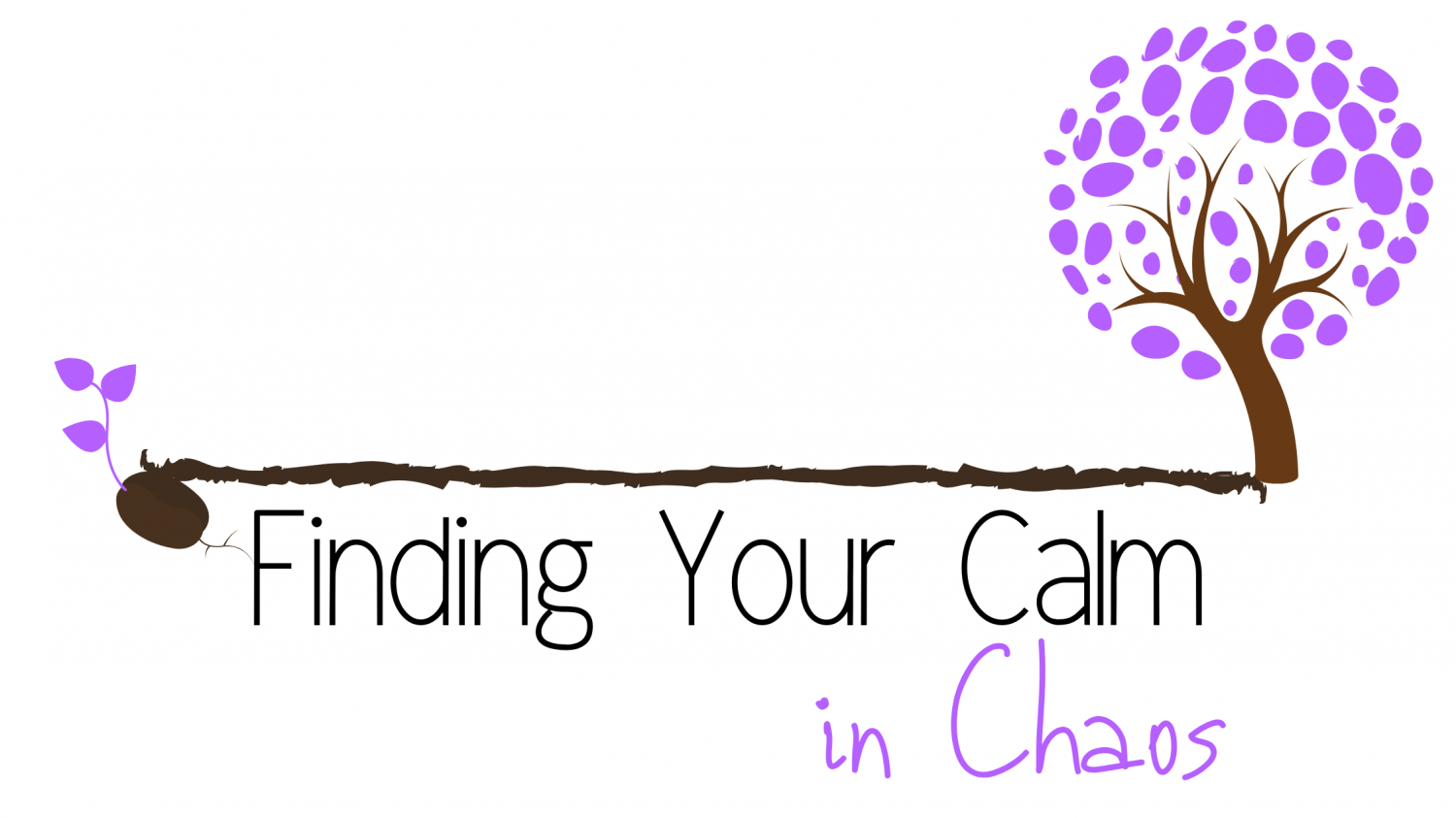

 CLICK HERE FOR COMMUNICATION TOOLBOX
CLICK HERE FOR COMMUNICATION TOOLBOX